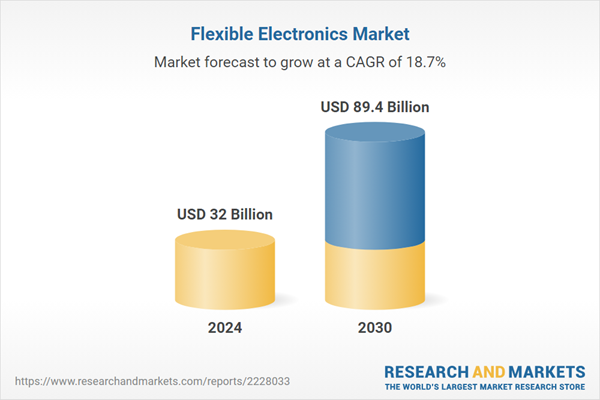Global Flexible Electronics Market - Key Trends & Drivers Summarized
Flexible electronics represent a groundbreaking advancement in the field of electronics, enabling the creation of devices that are not constrained by rigid forms. These electronics are built on flexible substrates such as plastic, metal foil, or flexible glass, allowing them to bend, fold, and stretch without losing functionality. The technology encompasses a wide range of applications, from flexible displays and wearable devices to medical implants and smart textiles. Flexible electronics are made possible through innovations in materials science, including the development of organic semiconductors, conductive polymers, and novel fabrication techniques like printing electronics. Techniques such as roll-to-roll printing and inkjet printing allow for the mass production of flexible circuits at lower costs compared to traditional silicon-based electronics. This flexibility opens up new possibilities for device design, making it feasible to integrate electronics into previously unworkable environments and surfaces, such as curved displays or wearable health monitors.One of the most prominent applications of flexible electronics is in the development of flexible displays and screens. These displays can be found in consumer electronics such as smartphones, tablets, and televisions, where they offer enhanced durability and new form factors. Companies like Samsung and LG are at the forefront of this innovation, producing foldable smartphones that transform from a standard phone into a larger tablet-like screen. These foldable devices utilize flexible OLED technology, which provides bright, high-contrast displays while being thin and flexible enough to bend. Additionally, flexible electronics are revolutionizing the wearable technology market. Smartwatches, fitness trackers, and health monitoring devices benefit from lightweight, conformable electronics that enhance user comfort and functionality. In the healthcare sector, flexible sensors and patches are being developed for continuous monitoring of vital signs, such as heart rate and blood pressure, offering a non-invasive and convenient solution for patient care. These applications demonstrate the transformative potential of flexible electronics across various industries, from consumer gadgets to advanced medical devices.
The growth in the flexible electronics market is driven by several factors, including technological advancements, increasing consumer demand for innovative and portable devices, and expanding applications in emerging fields. Continuous improvements in material science and fabrication techniques are making flexible electronics more reliable, efficient, and cost-effective. The consumer electronics industry, driven by a desire for novel and multifunctional devices, is a major driver of market growth. As consumers seek more durable, lightweight, and versatile electronic products, manufacturers are investing in flexible electronics to meet these demands. Additionally, the healthcare sector's increasing adoption of wearable health monitoring devices is contributing significantly to market expansion. These devices are particularly valuable for remote patient monitoring and personalized healthcare, aligning with the broader trend toward digital health solutions. Government support and funding for research and development in flexible electronics also play a crucial role, encouraging innovation and commercialization of new technologies. Large-scale governmental R&D funding programs in countries such as Japan, China, Taiwan, South Korea and the EU along with sustained R&D efforts from research entities and electronics & material technologies enterprises is poised to drive momentum in the market. Moreover, the integration of flexible electronics in automotive and industrial applications, such as flexible sensors for structural health monitoring and adaptive lighting systems, is opening new avenues for market growth. As these factors converge, the flexible electronics market is poised for substantial growth, driven by technological innovation, consumer demand, and broadening applications across various sectors.
Report Scope
The report analyzes the Flexible Electronics market, presented in terms of market value (USD). The analysis covers the key segments and geographic regions outlined below.- Segments: Component (Electronic Displays, Batteries, Other Components); Application (Consumer Electronics, Automotive, Energy & Power, Medical & Healthcare, Defense & Aerospace, Other Applications).
- Geographic Regions/Countries: World; USA; Canada; Japan; China; Europe; France; Germany; Italy; UK; Spain; Russia; Rest of Europe; Asia-Pacific; Australia; India; South Korea; Rest of Asia-Pacific; Latin America; Argentina; Brazil; Mexico; Rest of Latin America; Middle East; Iran; Israel; Saudi Arabia; UAE; Rest of Middle East; Africa.
Key Insights:
- Market Growth: Understand the significant growth trajectory of the Consumer Electronics Application segment, which is expected to reach US$60.3 Billion by 2030 with a CAGR of 19.7%. The Automotive Application segment is also set to grow at 17% CAGR over the analysis period.
- Regional Analysis: Gain insights into the U.S. market, valued at $5.3 Billion in 2024, and China, forecasted to grow at an impressive 22.2% CAGR to reach $40.5 Billion by 2030. Discover growth trends in other key regions, including Japan, Canada, Germany, and the Asia-Pacific.
Why You Should Buy This Report:
- Detailed Market Analysis: Access a thorough analysis of the Global Flexible Electronics Market, covering all major geographic regions and market segments.
- Competitive Insights: Get an overview of the competitive landscape, including the market presence of major players across different geographies.
- Future Trends and Drivers: Understand the key trends and drivers shaping the future of the Global Flexible Electronics Market.
- Actionable Insights: Benefit from actionable insights that can help you identify new revenue opportunities and make strategic business decisions.
Key Questions Answered:
- How is the Global Flexible Electronics Market expected to evolve by 2030?
- What are the main drivers and restraints affecting the market?
- Which market segments will grow the most over the forecast period?
- How will market shares for different regions and segments change by 2030?
- Who are the leading players in the market, and what are their prospects?
Report Features:
- Comprehensive Market Data: Independent analysis of annual sales and market forecasts in US$ Million from 2024 to 2030.
- In-Depth Regional Analysis: Detailed insights into key markets, including the U.S., China, Japan, Canada, Europe, Asia-Pacific, Latin America, Middle East, and Africa.
- Company Profiles: Coverage of players such as BASF SE, 3M Company, Applied Materials, Inc., Amphenol Corporation, AI Technology, Inc. and more.
- Complimentary Updates: Receive free report updates for one year to keep you informed of the latest market developments.
Some of the 61 companies featured in this Flexible Electronics market report include:
- BASF SE
- 3M Company
- Applied Materials, Inc.
- Amphenol Corporation
- AI Technology, Inc.
- Blue Spark Technologies
- AirBorn, Inc.
- Alba Elettronica Srl
- American Circuit Technology, Inc.
- Andus Electronic GmbH
- Circuitronics LLC
- Cirexx International, Inc.
- Cirly SAS
- CONTAG AG
- BrightVolt
This edition integrates the latest global trade and economic shifts into comprehensive market analysis. Key updates include:
- Tariff and Trade Impact: Insights into global tariff negotiations across 180+ countries, with analysis of supply chain turbulence, sourcing disruptions, and geographic realignment. Special focus on 2025 as a pivotal year for trade tensions, including updated perspectives on the Trump-era tariffs.
- Adjusted Forecasts and Analytics: Revised global and regional market forecasts through 2030, incorporating tariff effects, economic uncertainty, and structural changes in globalization. Includes historical analysis from 2015 to 2023.
- Strategic Market Dynamics: Evaluation of revised market prospects, regional outlooks, and key economic indicators such as population and urbanization trends.
- Innovation & Technology Trends: Latest developments in product and process innovation, emerging technologies, and key industry drivers shaping the competitive landscape.
- Competitive Intelligence: Updated global market share estimates for 2025, competitive positioning of major players (Strong/Active/Niche/Trivial), and refined focus on leading global brands and core players.
- Expert Insight & Commentary: Strategic analysis from economists, trade experts, and domain specialists to contextualize market shifts and identify emerging opportunities.
Table of Contents
Companies Mentioned (Partial List)
A selection of companies mentioned in this report includes, but is not limited to:
- BASF SE
- 3M Company
- Applied Materials, Inc.
- Amphenol Corporation
- AI Technology, Inc.
- Blue Spark Technologies
- AirBorn, Inc.
- Alba Elettronica Srl
- American Circuit Technology, Inc.
- Andus Electronic GmbH
- Circuitronics LLC
- Cirexx International, Inc.
- Cirly SAS
- CONTAG AG
- BrightVolt
Table Information
| Report Attribute | Details |
|---|---|
| No. of Pages | 120 |
| Published | December 2025 |
| Forecast Period | 2024 - 2030 |
| Estimated Market Value ( USD | $ 32 Billion |
| Forecasted Market Value ( USD | $ 89.4 Billion |
| Compound Annual Growth Rate | 18.7% |
| Regions Covered | Global |









